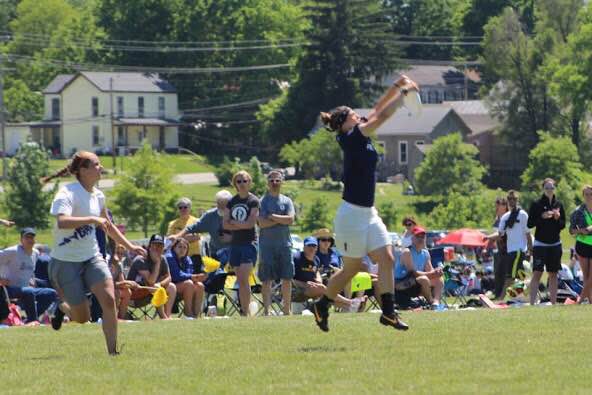Throw Blue: A Beginner’s Guide to Ultimate Frisbee at UMich
Sep 15th 2015

Of all the images that come to mind when I think of college, the most prominent is that of college students perfectly flinging frisbees in the quad, or in our case the Diag, and having the best time of their life. However, what a lot of people don’t know is this idea of “flinging a Frisbee around” is actually the building block of a highly-engaging team sport: Ultimate Frisbee.
To put it simply, Ultimate is a highly organized Frisbee toss. To do it justice, Ultimate is a high intensity endurance sport encompassing offensive and defensive coordination, athleticism, throwing and catching ability, teamwork, and dedication. In the case of Michigan Flywheel, it also depends on 6 day a week practices (sometimes at midnight), throwing in the Diag every day, 10 hour car drives to tournaments, and a lot of fly-love.
Ultimate Frisbee 101
The sport of Ultimate Frisbee (“Ultimate”, to the initiated) is played between 2 teams of 7. Each point begins with a “pull” – think thrown version of a football kick-off – from one team to another. Teams are comprised of handlers (whose primary job is to handle and work the disc) and cutters (who make quick “cuts” in order to get open for a throw). On offense, teams usually play either a vertical stack or a horizontal stack.
In vertical, there are 5 cutters and 2 handlers: the five cutters line up vertically in the middle of the field with the two handlers splitting the field at the end of the stack. For a horizontal stack, 4 players line up horizontally across the field 10-15 yards from 3 handlers evenly spread across the field. On offense, teams typically have a list of plays that they can rotate through, as well as letting the players on the field work together without a set play.
When possession changes, the team is forced to scramble into one of two defenses: man defense or zone defense. In man defense, each player guards one man and stays with them throughout the play, sometimes poaching off of their player if they are not a threat. In zone defense, each player primarily guards a space and can pick up certain individuals who pose a threat.
There are many types of zone defense, some involving cups, walls, chasers, deeps, and wings. Each player has their own specialized job in a “zone” formation. The cup includes the player marking the offender with the disc. Their job is to trap the offensive player to throw to a certain side of the field. Walls typically take up a little bit deeper space than a cup but occupy the same job as blocking cutters from reaching the handlers. As the name implies, Chasers work on the mark by putting pressure on handlers making short distance throws. Deep players make sure that any desperate long throws (or “hucks”, in ultimate lingo) are challenged. Finally, wings occupy the space after the cup/wall and before the deeps. Their job is to prevent up-line throws or continuation throws if the cup or wall is broken.
The College Season
The college ultimate season begins in February and ends at Nationals in late May. Teams attend unsanctioned tournaments in the fall in order to build team chemistry and gain experience. During the sanctioned season, college teams move mountains to play at a handful of various tournaments around the country. More often than not, this includes 5 a.m. flights to Texas and 16-hour drives to Virginia – quite a tall order when Monday morning might mean an early midterm after a long return trip.
But, we do it all for the love of the sport! Playing in these rare “sanctioned” tournaments is the only way to acquire points and better your team’s USAU (USA Ultimate) ranking. Points are allocated based on a team’s tournament-long margin of victory and the team’s previous ranking the year before. At the end of the season, these points decide the top teams in the nation. Being in the Top 20 betters your chances of earning a bid to the National Collegiate Tournament (“Nationals”), but it is also never a sure way to make the tournament.
The Road to Nationals
I wouldn’t play for any other program than Michigan Flywheel. The top-notch coaching staff and talented teammates make the season worthwhile. It is because of the coaching and players on Michigan Flywheel that we are continually ranked in the top in the region to go the Nationals. Nationals, the end of the college season, is a tournament of the top 20 teams in the nation. Each region in the United States is allocated one bid, and the remaining bids are given to regions if they have more than one team in ranked in the USAU top 20. Each team moves from sectionals to regionals in hopes of being one of the few teams to attend Nationals.
Play at UM! Join Michigan Flywheel
Flywheel prides itself on being a team that requires each individual player to be their best. We all know of teams where the focus is on one key player who takes the team to the top; Flywheel is not that team. Michigan Flywheel requires every player to work hard, every player to do their job, and every player to work together for one common goal. We practice six days a week, take field space at midnight, run track workouts, and cross-train for each other.
No one is exempt from giving their all at any practice or any tournament. Every Flywheel player has a mutual respect and genuine love for their teammates – otherwise, they simply couldn’t balance school, life, and the sport they love. They train hard for each other. They drive through the night for each other. Michigan Flywheel isn’t about star players or natural talent; Michigan Flywheel is all about The Team.
